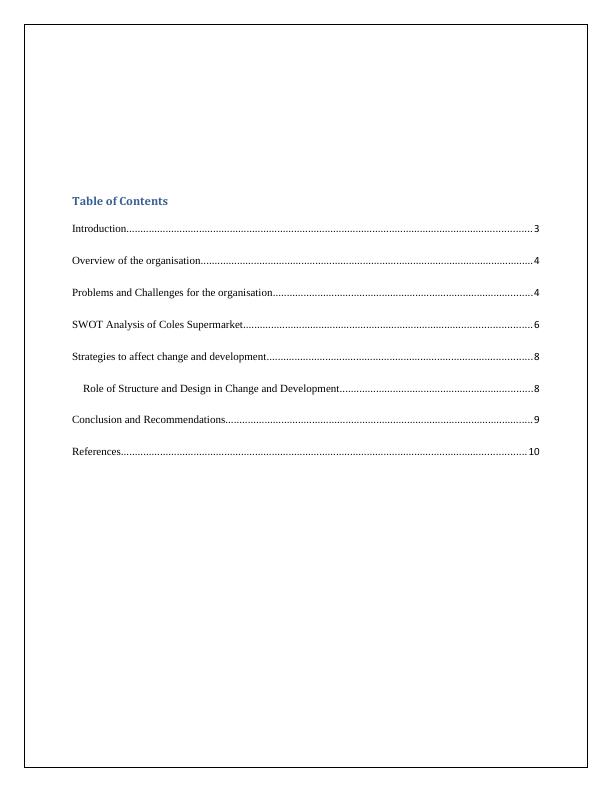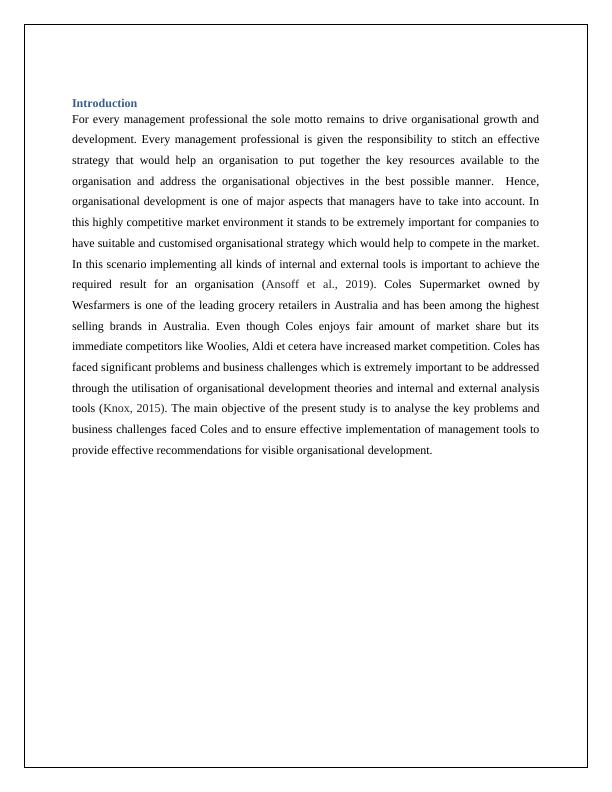Organisational Development: Case Study of Coles Supermarket
Added on 2023-01-17
11 Pages3330 Words49 Views
Organisational Development
Case study of Coles Supermarket
Case study of Coles Supermarket

Table of Contents
Introduction.................................................................................................................................................3
Overview of the organisation.......................................................................................................................4
Problems and Challenges for the organisation.............................................................................................4
SWOT Analysis of Coles Supermarket.......................................................................................................6
Strategies to affect change and development...............................................................................................8
Role of Structure and Design in Change and Development.....................................................................8
Conclusion and Recommendations..............................................................................................................9
References.................................................................................................................................................10
Introduction.................................................................................................................................................3
Overview of the organisation.......................................................................................................................4
Problems and Challenges for the organisation.............................................................................................4
SWOT Analysis of Coles Supermarket.......................................................................................................6
Strategies to affect change and development...............................................................................................8
Role of Structure and Design in Change and Development.....................................................................8
Conclusion and Recommendations..............................................................................................................9
References.................................................................................................................................................10

Introduction
For every management professional the sole motto remains to drive organisational growth and
development. Every management professional is given the responsibility to stitch an effective
strategy that would help an organisation to put together the key resources available to the
organisation and address the organisational objectives in the best possible manner. Hence,
organisational development is one of major aspects that managers have to take into account. In
this highly competitive market environment it stands to be extremely important for companies to
have suitable and customised organisational strategy which would help to compete in the market.
In this scenario implementing all kinds of internal and external tools is important to achieve the
required result for an organisation (Ansoff et al., 2019). Coles Supermarket owned by
Wesfarmers is one of the leading grocery retailers in Australia and has been among the highest
selling brands in Australia. Even though Coles enjoys fair amount of market share but its
immediate competitors like Woolies, Aldi et cetera have increased market competition. Coles has
faced significant problems and business challenges which is extremely important to be addressed
through the utilisation of organisational development theories and internal and external analysis
tools (Knox, 2015). The main objective of the present study is to analyse the key problems and
business challenges faced Coles and to ensure effective implementation of management tools to
provide effective recommendations for visible organisational development.
For every management professional the sole motto remains to drive organisational growth and
development. Every management professional is given the responsibility to stitch an effective
strategy that would help an organisation to put together the key resources available to the
organisation and address the organisational objectives in the best possible manner. Hence,
organisational development is one of major aspects that managers have to take into account. In
this highly competitive market environment it stands to be extremely important for companies to
have suitable and customised organisational strategy which would help to compete in the market.
In this scenario implementing all kinds of internal and external tools is important to achieve the
required result for an organisation (Ansoff et al., 2019). Coles Supermarket owned by
Wesfarmers is one of the leading grocery retailers in Australia and has been among the highest
selling brands in Australia. Even though Coles enjoys fair amount of market share but its
immediate competitors like Woolies, Aldi et cetera have increased market competition. Coles has
faced significant problems and business challenges which is extremely important to be addressed
through the utilisation of organisational development theories and internal and external analysis
tools (Knox, 2015). The main objective of the present study is to analyse the key problems and
business challenges faced Coles and to ensure effective implementation of management tools to
provide effective recommendations for visible organisational development.

Overview of the organisation
Coles Supermarket is one of the biggest retail giants operating in the Australian market. The
organisation is around 105 years old and operates over 850 locations all across the country.
Founded in 1914 the organisation slowly and steadily crossed each and every stair through
effective quality products and excellent customer service. The organisation has around 12000
employees working in the different locations and is considered one of the effective and largest
employers in the retail sector in Australia. Since its takeover by Wesfarmers in 2007 Coles has
expanded significantly in different countries which has increased sales and revenue substantially.
In the last few years Coles had to face significant competition from companies like Woolworths,
Aldi and certain organic food groceries who have effectively captured the market (Wheelen et
al., 2017). Even in competition the organisations stood strong with its effective mission, vision
and objectives.
The mission of the organisation is to “Gain customer satisfaction through better service and
operating excellence”. The organisation wants to become the number one retailer in the country
through effective and friendly service provided to the consumers. It also emphasises on
innovation that helps the organisation to achieve competitive advantage in the market. It clearly
states that innovation has to be at the core of operations in Coles to be at consumers’ disposal
and address their needs in the best possible manner. In the last few years with increasing
competition Coles has had to face hiccups in terms of business as there are number of aspects
which emerged in the market (Rothaermel, 2015). There have been questions on the operations
of Coles mostly from the ethical consumers and also about its business practice and corporate
governance which are some of the key business challenges faced by the organisation apart from
increasing competition.
Problems and Challenges for the organisation
A business has to keep up with the pace of changing trends in a market constantly to sustain. It
cannot be denied that the global retail industry is one of the most competitive industries in the
world and hence it is extremely essential for the players in the market to have effective strategy
working for them. Over the years the Australian retail market has become competitive with the
emergence of new retail organisations. Different companies follow different strategies which
affects the existing businesses to a large extent as they fail to cope up with the increasing
Coles Supermarket is one of the biggest retail giants operating in the Australian market. The
organisation is around 105 years old and operates over 850 locations all across the country.
Founded in 1914 the organisation slowly and steadily crossed each and every stair through
effective quality products and excellent customer service. The organisation has around 12000
employees working in the different locations and is considered one of the effective and largest
employers in the retail sector in Australia. Since its takeover by Wesfarmers in 2007 Coles has
expanded significantly in different countries which has increased sales and revenue substantially.
In the last few years Coles had to face significant competition from companies like Woolworths,
Aldi and certain organic food groceries who have effectively captured the market (Wheelen et
al., 2017). Even in competition the organisations stood strong with its effective mission, vision
and objectives.
The mission of the organisation is to “Gain customer satisfaction through better service and
operating excellence”. The organisation wants to become the number one retailer in the country
through effective and friendly service provided to the consumers. It also emphasises on
innovation that helps the organisation to achieve competitive advantage in the market. It clearly
states that innovation has to be at the core of operations in Coles to be at consumers’ disposal
and address their needs in the best possible manner. In the last few years with increasing
competition Coles has had to face hiccups in terms of business as there are number of aspects
which emerged in the market (Rothaermel, 2015). There have been questions on the operations
of Coles mostly from the ethical consumers and also about its business practice and corporate
governance which are some of the key business challenges faced by the organisation apart from
increasing competition.
Problems and Challenges for the organisation
A business has to keep up with the pace of changing trends in a market constantly to sustain. It
cannot be denied that the global retail industry is one of the most competitive industries in the
world and hence it is extremely essential for the players in the market to have effective strategy
working for them. Over the years the Australian retail market has become competitive with the
emergence of new retail organisations. Different companies follow different strategies which
affects the existing businesses to a large extent as they fail to cope up with the increasing

End of preview
Want to access all the pages? Upload your documents or become a member.
Related Documents
Grocery and Supermarket Industry in Australialg...
|7
|1274
|318
Coles: Overview, Vision and Strategic Objectiveslg...
|6
|1200
|277
Internal And External Factors Analysislg...
|9
|1411
|286
Marketing In Australia Analysis 2022lg...
|13
|2648
|17
Assignment on Analysis about Woolworthslg...
|14
|3259
|53
Strategic Analysis of Australian Supermarket Industrylg...
|10
|2879
|350